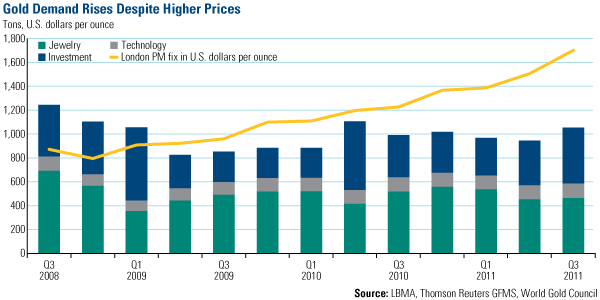Gold's Triple Play: Volatility, Currencies And Europe
posted on
Nov 25, 2011 10:43AM

Potential to earn a 60 percent interest in property located adjacent to Goldcorp's Hollinger and McIntyre mines

Resurgent investment lifted global gold demand 6% from the previous year to just over 1,000 tons during the third quarter of 2011, according to the latest Gold Demand Trends Report from the World Gold Council (WGC).
The potent cocktail of inflationary pressures in the emerging world and the European sovereign debt fiasco left investors searching for a safe haven that they found in gold.
In an uncertain era when many asset values are declining, gold has thrived. Gold prices averaged $1,700 an ounce during the third quarter of 2011, 39% higher than the same time last year and 13% above the previous quarter, according to the WGC.

In total, investment demand increased 33% on a year-over-year basis to reach the third-highest quarter of investment demand on record, says the WGC. The increase was broad in scope. Investment in gold bars and coins jumped 29% year-over-year while holdings in gold ETFs reached an all-time high.
All global markets other than India, Japan and the U.S. experienced gains in investment demand; many of them (except Thailand and Saudi Arabia) saw double-digit increases.
While investment demand thrived during the third quarter, jewelry demand fell victim to the quarter’s economic fragility and price volatility—falling 10% on a year-over-year basis. Only four markets—China, Hong Kong, Japan and Russia—saw jewelry demand increase.
The WGC says a shift toward high-growth economies is “undeniably conspicuous in the gold market.” Nowhere in the world is this more evident than in China, where consumer thirst for gold appears unquenchable. China’s total demand, around 612 tons year-to-date, has already eclipsed that of 2010. In addition to domestically consuming every speck of gold mined in China, it’s estimated that the country’s gold imports could reach 400 tons in 2011. That’s roughly equal to the combined tonnage of gold demand for the Middle East, Turkey and Indonesia in 2010, and that’s just imports.
Consumer demand for gold in China increased 13 percent (year-over-year) during the third quarter as the country continues to close the gap on India. Chinese jewelry demand, also up 13 percent, eclipsed India for only the fourth time since January 2003. Combined, the two Asian giants account for over 50 percent of global jewelry demand.
The WGC says, “China’s increase in demand is being fueled by rising income levels, a by-product of China’s rapid economic growth.” This growth has given birth to more than 100 million gold bugs in China’s rural areas. China’s smaller third- and fourth-tier cities were responsible for the bulk of the increase in jewelry demand, the WGC says. In addition, the Gold Accumulation Plan (GAP), a joint effort from the Industrial & Commercial Bank of China (ICBC) and the WGC which allows investors to purchase gold in small increments, reached 2 million accounts in September. The WGC says GAP sales have already exceeded 19 tons so far this year.
Things weren’t quite as rosy for demand in the world’s second-largest jewelry market. Indian jewelry demand took a 26 percent hit as volatility in the rupee shook investor confidence. The rupee decreased 9 percent against the U.S. dollar during the third quarter, more than double the currency’s average quarterly move over the past five years.
Historically, Indian jewelry demand bottoms in July-August, before picking up heading into the Shradh period of the Hindu calendar. That didn’t happen this year because Indian consumers were discouraged by high and volatile prices. The WGC says:
Consumer confidence in India has been knocked by the persistence of high domestic inflation rates. Inflation of almost 10 percent, as measured by the Wholesale Price Index (WPI), adversely affected jewelry demand, through its impact on both disposable income levels and general consumer sentiment.”
The weaknesses of the rupee against the U.S. dollar also negatively affected India’s demand. This chart illustrates the dramatic effect currency fluctuations can have on gold prices.

The gold price in Indian rupees has appreciated over 31 percent since June 30, more than three times the price appreciation denominated in Japanese yen. This means that a consumer looking to buy gold in Japan would have three times the purchasing power to buy gold at their local dealer than an Indian counterpart.
Source: http://www.forbes.com/sites/greatspeculations/2011/11/25/golds-triple-play-volatility-currencies-and-europe/